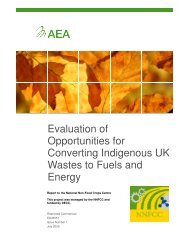Consumption and the environment (SOER2010) - European ...
Consumption and the environment (SOER2010) - European ...
Consumption and the environment (SOER2010) - European ...
Create successful ePaper yourself
Turn your PDF publications into a flip-book with our unique Google optimized e-Paper software.
Thematic assessment | <strong>Consumption</strong> <strong>and</strong> <strong>the</strong> <strong>environment</strong><br />
<strong>the</strong> building of facilities such as hotels, second homes or<br />
tourism infrastructure <strong>and</strong> activities at <strong>the</strong> destinations<br />
(Figure 7.1). Life‐cycle assessment studies on tourism are<br />
sparse <strong>and</strong> often related to a specific hotel or destination<br />
(De Camillis et al., 2010).<br />
Transport connected to tourism accounts for about 8 %<br />
of GHG emissions in <strong>the</strong> EU‐15 (Working Group on<br />
Sustainable Tourism, 2007) <strong>and</strong> <strong>the</strong> choice of transport<br />
mode to <strong>and</strong> from <strong>the</strong> destination is by far <strong>the</strong> most<br />
influential factor in overall GHG emissions from tourism, as<br />
illustrated by <strong>the</strong> emissions associated with different types<br />
of typical holiday trips of German tourists (Figure 7.2).<br />
In <strong>the</strong> EU‐15, most trips are made by car, followed by air.<br />
Car travel accounts for about 41 % of GHG emissions from<br />
tourism (Working Group on Sustainable Tourism, 2007),<br />
<strong>and</strong> trips made by plane account for about 55 % despite<br />
only being used for 20 % of trips (UNWTO <strong>and</strong> UNEP,<br />
2008). In <strong>the</strong> Mediterranean countries, <strong>the</strong> share of tourists<br />
arriving by plane increased from 23 % to 40 % between 1988<br />
<strong>and</strong> 2006 (UNEP/MAP‐Plan Bleu, 2009).<br />
Some tourist activities, such as swimming <strong>and</strong> golf, are<br />
responsible for heavy water use, often in regions with<br />
few water resources. In sensitive regions such as <strong>the</strong><br />
Mediterranean or <strong>the</strong> Alps, tourism is thus an important<br />
cause of water shortages <strong>and</strong> <strong>the</strong> degradation of water<br />
supplies (EEA, 2009a; EEA, 2010c, 2010d). In order to meet<br />
high tourist water dem<strong>and</strong>s, in some cases drinking water<br />
is even transported over long distances by ship, for example<br />
to some of <strong>the</strong> Greek isl<strong>and</strong>s (EEA, 2010b).<br />
Although highly dependent on <strong>environment</strong>al quality,<br />
tourism, through <strong>the</strong> construction of hotels, second/<br />
holiday homes, marinas, skiing facilities, <strong>and</strong> o<strong>the</strong>r<br />
attractions, is an important driver of l<strong>and</strong> take <strong>and</strong><br />
degradation, especially in coastal areas. Toge<strong>the</strong>r with<br />
o<strong>the</strong>r tourism‐related pressures, such as over‐visiting<br />
vulnerable habitats, disturbance of wildlife, sale of<br />
endangered species to tourists, trampling of dune<br />
<strong>environment</strong>s, this contributes to <strong>the</strong> loss of habitats for<br />
wildlife (UNEP/MAP/BLUEPLAN, 2008; see also EEA,<br />
2010e). Tourism based on observation of marine wildlife<br />
is both an opportunity <strong>and</strong> a threat to biodiversity if <strong>the</strong><br />
intensity of such activities is not controlled (UNEP/MAP/<br />
BLUEPLAN, 2008).<br />
The growth in tourism is proving to be especially<br />
<strong>environment</strong>ally damaging in some mass tourist<br />
destinations such as <strong>the</strong> Mediterranean coasts <strong>and</strong> isl<strong>and</strong>s<br />
<strong>and</strong> <strong>the</strong> Alps. And as mass tourism spreads fur<strong>the</strong>r to<br />
<strong>the</strong> coastal areas of <strong>the</strong> Sou<strong>the</strong>rn Baltic Sea, Brittany<br />
<strong>and</strong> <strong>the</strong> Black Sea, similar <strong>environment</strong>al degradation is<br />
occurring <strong>and</strong> can be expected to continue (EEA, 2006).<br />
In <strong>the</strong> Alps, winter tourism is growing rapidly, often<br />
extended by artificial snow‐making, which is not only<br />
energy‐intensive but has high water dem<strong>and</strong> in a season<br />
of low water levels, thus putting pressures on lakes, rivers<br />
<strong>and</strong> groundwater, <strong>and</strong> enhances flood risks when <strong>the</strong> snow<br />
melts (EEA, 2009b).<br />
7.3 Tourism outlooks <strong>and</strong> scenarios<br />
Before <strong>the</strong> economic recession, total tourist travel was<br />
forecast to grow by 122 % between 2000 <strong>and</strong> 2020, with a<br />
related increase in CO 2<br />
emissions from <strong>European</strong> tourism<br />
of 85 % (Simpson et al., 2008). Tourist air travel is expected<br />
Figure 7.2<br />
GHG emissions for some types of holiday trips from Germany, CO 2<br />
‐equivalent<br />
per person per day<br />
Staycation (14 days, 4 persons)<br />
Family holiday Ruegen, Germany (car, 14 days, 4 persons)<br />
Wellness holiday Allgaeu, Germany (train, 10 days, 3 persons)<br />
Culture holiday, South Tyrol (bus, 5 days, 2 persons)<br />
Skiing holiday, Austria (car, 7 days, 1 person)<br />
Beach holiday, Majorca (plane, 14 days, 3 persons)<br />
Mediterranean cruise (plane, 7 days, 2 persons)<br />
All-inclusive holiday Mexico (plane, 14 days, 4 persons)<br />
0 200 400 600<br />
CO 2<br />
-equivalent per person per day<br />
Travel Accomodation Food On-location activities<br />
Note:<br />
Staycation means a holiday at home with holiday activities locally.<br />
Source: WWF, 2009.<br />
42<br />
The <strong>European</strong> <strong>environment</strong> | State <strong>and</strong> outlook 2010








